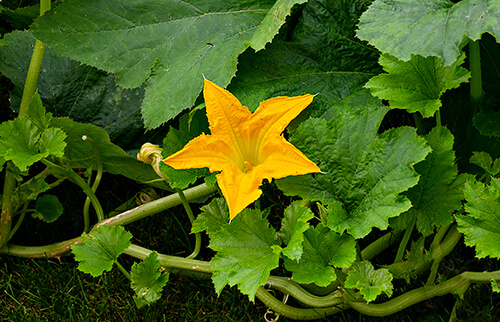Powdery Mildew is a Big Problem for Cucurbits
Jul 27, 2020

By Ben Gilbert, TFC Specialty Crops Specialist
One of the biggest issues we face today in Cucurbits is powdery mildew. This article will shed some light on the issue and the information you need to control it.
The first sign of powdery mildew is pale yellow leaf spots. Symptoms first appear mid to late summer in Tennessee. White powdery spots can form on both upper and lower leaf surfaces, and quickly expand into large blotches. It will almost appear as if someone has dusted plants with flower.
In warm, dry conditions, new spores form and easily spread the disease. Powdery mildew, mainly caused by the fungus Podosphaera xanthii, infects all cucurbits, including muskmelons, squash, cucumbers, gourds, watermelons and pumpkins. Powdery mildew is a common disease of cucurbits under field and greenhouse conditions in most areas of the world. Although all cucurbits are susceptible, symptoms are less common on cucumber and melon because many commercial cultivars have resistance.
This disease can be a major problem. Yield is reduced due to a decrease in the size or number of fruit or a decrease in the length of the harvest period. Plants that are infected can have loss of leaves which allows fruit to become sunburnt or ripen prematurely or incompletely. Infected plants grower smaller and less produce. Such fruit have poor shelf life (winter squash), poor flavor (melon), poor rind color (pumpkin), and shriveled, discolored stems (pumpkin).
Stress from disease can lead to imperfections on fruit such as speckling, raised indentations. Also, powdery mildew infection plants will be more suitable to other diseases, in particular, gummy stem blight.
Effectively managing powdery mildew is critical for producing a high-quality cucurbit crop. This foliar, fungal disease is common wherever cucurbits are grown. This is because the pathogen produces large amounts of asexual spores (the powdery growth) easily moved by wind and the pathogen can produce a sexual spore in the fall that allows it to survive through the winter.
Powdery mildew is managed with resistant varieties and fungicides. An integrated program with both management tools is the best approach for effective control because the pathogen can multiply so quickly. To learn more on controlling powdery mildew with fungicides, reach out to any of the local co-op agronomist in your area.
One of the biggest issues we face today in Cucurbits is powdery mildew. This article will shed some light on the issue and the information you need to control it.
The first sign of powdery mildew is pale yellow leaf spots. Symptoms first appear mid to late summer in Tennessee. White powdery spots can form on both upper and lower leaf surfaces, and quickly expand into large blotches. It will almost appear as if someone has dusted plants with flower.
In warm, dry conditions, new spores form and easily spread the disease. Powdery mildew, mainly caused by the fungus Podosphaera xanthii, infects all cucurbits, including muskmelons, squash, cucumbers, gourds, watermelons and pumpkins. Powdery mildew is a common disease of cucurbits under field and greenhouse conditions in most areas of the world. Although all cucurbits are susceptible, symptoms are less common on cucumber and melon because many commercial cultivars have resistance.
This disease can be a major problem. Yield is reduced due to a decrease in the size or number of fruit or a decrease in the length of the harvest period. Plants that are infected can have loss of leaves which allows fruit to become sunburnt or ripen prematurely or incompletely. Infected plants grower smaller and less produce. Such fruit have poor shelf life (winter squash), poor flavor (melon), poor rind color (pumpkin), and shriveled, discolored stems (pumpkin).
Stress from disease can lead to imperfections on fruit such as speckling, raised indentations. Also, powdery mildew infection plants will be more suitable to other diseases, in particular, gummy stem blight.
Effectively managing powdery mildew is critical for producing a high-quality cucurbit crop. This foliar, fungal disease is common wherever cucurbits are grown. This is because the pathogen produces large amounts of asexual spores (the powdery growth) easily moved by wind and the pathogen can produce a sexual spore in the fall that allows it to survive through the winter.
Powdery mildew is managed with resistant varieties and fungicides. An integrated program with both management tools is the best approach for effective control because the pathogen can multiply so quickly. To learn more on controlling powdery mildew with fungicides, reach out to any of the local co-op agronomist in your area.